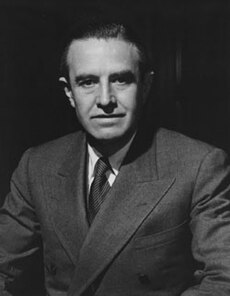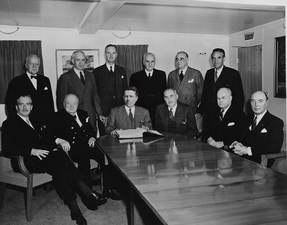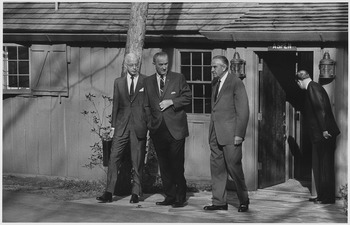Lysander Hughes
Lysander Hughes | |||||||||||||||||||||||||
|---|---|---|---|---|---|---|---|---|---|---|---|---|---|---|---|---|---|---|---|---|---|---|---|---|---|
 Hughes in 1955 | |||||||||||||||||||||||||
| General Secretary of the Continentalist Party | |||||||||||||||||||||||||
|
In office 15 July 1953 – 19 December 1958 | |||||||||||||||||||||||||
| Preceded by | Amelia Crawford | ||||||||||||||||||||||||
| Succeeded by | Charles Acker | ||||||||||||||||||||||||
| President of the United Commonwealth | |||||||||||||||||||||||||
|
In office 20 November 1956 – 19 December 1958 | |||||||||||||||||||||||||
| Preceded by | TBD | ||||||||||||||||||||||||
| Succeeded by | TBD | ||||||||||||||||||||||||
| Member of the 6th–11th Presidiums | |||||||||||||||||||||||||
|
In office 15 November 1936 – 19 December 1958 | |||||||||||||||||||||||||
| Member of the Secretariat | |||||||||||||||||||||||||
|
In office | |||||||||||||||||||||||||
| |||||||||||||||||||||||||
| Personal details | |||||||||||||||||||||||||
| Born |
17 April 1897 Pennsport, Philadelphia, Pennsylvania, United Commonwealth | ||||||||||||||||||||||||
| Died |
19 December 1958 (aged 61) Chicago, Illinois, United Commonwealth | ||||||||||||||||||||||||
| Resting place | Crimson Square Necropolis, Chicago | ||||||||||||||||||||||||
| Nationality | Continental | ||||||||||||||||||||||||
| Political party |
| ||||||||||||||||||||||||
| Spouse(s) | Anne Kelly | ||||||||||||||||||||||||
| Children | 5 children | ||||||||||||||||||||||||
| Alma mater | Lafayette College (BA) | ||||||||||||||||||||||||
| Religion |
Irreligious (Raised Catholic) | ||||||||||||||||||||||||
| Military service | |||||||||||||||||||||||||
| Allegiance |
| ||||||||||||||||||||||||
| Branch/service | Continental Revolutionary Army | ||||||||||||||||||||||||
| Years of service | 1918–1921 | ||||||||||||||||||||||||
| Rank |
| ||||||||||||||||||||||||
| Unit | 4th Infantry Division | ||||||||||||||||||||||||
| Battles/wars | Continental Revolutionary War | ||||||||||||||||||||||||
| Awards | See below | ||||||||||||||||||||||||
|
| |||||||||||||||||||||||||
Lysander Hughes (17 April 1897 – 19 December 1958) was a Continental statesman and politician who ruled as paramount leader of the United Commonwealth from 1953 until his death in 1958, succeeding Amelia Fowler Crawford as General Secretary of the Continentalist Party. He was also President of the United Commonwealth after 1956, a member of the 6th–11th Presidiums (1936–1958), a member of the Secretariat (1940–1958), and a full member of the 16th–22nd Central Committees (1936–1958).
Hughes was born in Pennsport, Philadelphia in 1897, the son of a local store owner of Irish and German descent. His paternal grandfather was an officer in the War of Contingency, two of Hughes’ uncles served in the Hispaniola Wars, and his maternal grandfather was a wealthy farmer in southeast Pennsylvania. In 1914 he enrolled at Lafayette College, graduating with a Bachelor of Arts in government with a focus on international affairs. He enrolled at the University of Pennsylvania intending to study law, but by that time also became an active supporter of the growing Continentalist movement, which had erupted into the Continental Revolutionary War.
In 1918 Hughes joined the Continental Revolutionary Army as a volunteer, fighting in the Battle of Homestead’s Revenge in Pennsylvania, and taking part in the Southern Campaign. He joined the Continentalist Party in 1920 and worked as a political commissar, becoming noted for his bravery and knowledge of Landonism. On 7 November 1920, Hughes would be severely wounded when his boat was shelled during a night crossing of the Savannah River. Despite this, he managed to pull himself and his crew to safety and was awarded the Order of the Red Banner of Labor for his bravery. He would suffer from chronic back pain for the rest of his life after the incident. Post-revolution Hughes attended classes at the Illinois Institute of Technology, and briefly worked as a newspaper correspondent, but quickly became more renown for his activism in veteran affairs and housing reform. He caught the attention of Seamus Callahan, who had Hughes appointed to the Organizational Bureau of the Central Committee. He gradually rose through the ranks of the Party’s bureaucracy, also being elected to the National People's Congress in 1932, to the Central Committee in 1938, and to the Secretariat in 1940.
Toward the end of Great War I Hughes was promoted to the Central Military Commission, where he had a hand in shaping economic decisions and the post-war rebuilding. In 1941 he was appointed one of six directors (along with Callahan, People's Commissar for Defense Omar Radford, Hoyt Vandenberg, James B. Conant, and Vannevar Bush) of the secret Scientific Research and Development Committee, which coordinated the United Commonwealth’s nuclear program. The program would produce the world’s first detonation of a nuclear weapon in 1945.
After the death of Callahan in 1947, Hughes was one of a few upper level leaders of the United Commonwealth associated with Callahan that navigated through his succession crisis unscathed. Although he was one who could stake a claim to be Callahan’s successor, he instead aligned with Vandenberg, who formed part of the Second Triumvirate until 1950, and was supportive of Amelia Crawford as General Secretary. As a result, Hughes was appointed speaker of the National People's Congress and briefly was Vice Premier of the Council of People's Commissars during the Crawford administration. However, Crawford’s handling of the Irish Missile Crisis and other policies led to her ousting in 1953, at which time Hughes was positioned to succeed her as General Secretary.
As paramount leader, Hughes would govern over one of the greatest eras of economic expansion and prosperity in Continental history, leading to an increase in standard of living and consumerism. Central to his outlook was the “New Frontier”, or the belief that the United Commonwealth should be guided by socialism through science, reason rather than sheer will, and technological innovation. Under Hughes, scientific discovery and innovation was prioritized, leading to optimism for a futurist vision of communism. Hughes continued the expansion of the country’s nuclear arsenal, developing the more powerful thermonuclear bomb, however, he also believed that nuclear power could be used for civil purposes and become the answer to the world’s electricity needs, as articulated in his 1953 “Atoms for Peace” speech to the League of Nations. The world’s first full-scale atomic electric power plant would begin operation in 1957. One of his chief goals became the exploration of space, which began a Space Race with the Western Bloc. In 1957 the United Commonwealth launched the world’s first artificial satellite into space, and Hughes invigorated public interest for the goal of landing a man on the moon, including in the famed “We choose to go to the Moon” speech which opened the 22nd Congress of the Continentalist Party in 1958.
Hughes committed Continental forces against the nations of France and Russia for the elimination of Derzhavism, calling for an “Arsenal of Democracy” to economically and militarily aid Continental European allies, such as Ireland, Italy, and Spain. He called the Continental mission the “fulfillment of the American Dream" and the fight for “Freedom from Want and Fear”, which included healthcare, housing, education, and employment as tenets of a “new Bill of Rights for mankind”. Along with Jack Spruance, Hughes spearheaded economic reforms to achieve price stability and unemployment, and decentralized or reversed some aspects of the Callahan-era economy. His administration saw the discovery of vaccines for diseases such as polio, and Hughes called for a global initiative to eradicate smallpox. The United Commonwealth would donate approximately two billion smallpox vaccines between 1955 and 1978, contributing to its global eradication by that time. Hughes oversaw the beginnings of the Digital Revolution, and just before his death supported research toward a national computer network, which would become a computerized system for resource allocation and the beginning of the internet.
Hughes died on 19 December 1958 while in Chicago by an intracerebral hemorrhage, likely exacerbated by hypertension, stress, and medication for his back pain. He was buried at a state funeral in the Crimson Square Necropolis. His reign marked the decline of the marriage of General Secretary with the position of paramount leader, with his successor Rupert Gardner not occupying the office.
Early life and career
Rise to power
Leader (1953–1958)
Hughes (top right) with Seamus Callahan (center) during Great War I.
Hughes (right) with President Kit Mather (center) and Premier Bill Masterson of Brazoria in 1957.
Death
Ideology and legacy
Awards and honors
 Hero of Socialist Labor (x2) (1945)(1957)
Hero of Socialist Labor (x2) (1945)(1957) Order of the Red Banner of Labor (1920)
Order of the Red Banner of Labor (1920) Order of Victory (1938)
Order of Victory (1938) Order of the Revolution (1948)
Order of the Revolution (1948) Order of the Red Star (x2) (1953)(1956)
Order of the Red Star (x2) (1953)(1956) Order of Sherman, 1st class (1940)
Order of Sherman, 1st class (1940) Medal "For Strengthening of Brotherhood in Arms" (1947)
Medal "For Strengthening of Brotherhood in Arms" (1947) Jubilee Medal "XX Years of the Peoples' Continental Army (1937)
Jubilee Medal "XX Years of the Peoples' Continental Army (1937)
 Tournesol: Order of the Golden Star of Topèque (1940)
Tournesol: Order of the Golden Star of Topèque (1940)
 Quebec: Order of Ormeaux (1945)
Quebec: Order of Ormeaux (1945)
 Ireland: Order of the United Ireland (1954)
Ireland: Order of the United Ireland (1954)
 Italy: Order of the Star of Italy (1955)
Italy: Order of the Star of Italy (1955)
 Spain: Laureate Cross of the Peninsula (1957)
Spain: Laureate Cross of the Peninsula (1957)
 Placentia: Order of the White Whale (1954)
Placentia: Order of the White Whale (1954)
See also
- List of leaders of the United Commonwealth
- General Secretary of the Continentalist Party of the United Commonwealth
| Political offices | ||
|---|---|---|
| Preceded by | President of the United Commonwealth 1956−1958 |
Succeeded by |
| Party political offices | ||
| Preceded by | General Secretary of the Continentalist Party of the United Commonwealth 1953–1958 |
Succeeded by |
- D-class articles
- Altverse II
- Continentals (Altverse II)
- Continental politicians (Altverse II)
- 1897 births
- 1958 deaths
- 20th-century Continental politicians
- Burials at the Crimson Square Necropolis
- Central Committee of the Continentalist Party of the United Commonwealth members
- Continental people of German descent
- Continental people of Irish descent
- Continental Revolutionary Army officers
- Deaths from cerebrovascular disease
- General Secretaries of the Continentalist Party
- Former Roman Catholics
- Lafayette College alumni
- Leaders of the United Commonwealth
- Order of the Red Banner of Labor recipients
- Order of the White Whale recipients
- People from Philadelphia
- Presidents of the United Commonwealth
- Secretariat of the Central Committee of the Continentalist Party of the United Commonwealth members



